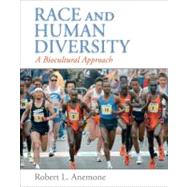
Robert Anemone is a biological anthropologist (Ph.D. 1988, University of Washington) with research interests in primate paleontology, growth and development and life history of hominoids, and functional anatomy of living and fossil prosimian primates. He has an active vertebrate paleontology research program in the Paleocene and Eocene of the Great Divide Basin in southwestern Wyoming, where he has been leading field crews since 1994. Before coming to Western Michigan University in 1998, he taught at Tulane University and at the State University of New York at Geneseo.
Table of Contents
Epigraph and Dedication
Preface
1. Race and Biological Diversity in Humans
1.1 On the (non-) existence of human races
1.2 Defining race
1.3 The nature of biological variation in Homo sapiens
1.4 The arbitrariness of the race concept
1.5 An alternative approach to the study of human diversity
1.6 A note on terminology: using the “R” word
1.7 Discussion Questions
1.8 Works Cited
2. Charles Darwin and Evolutionary Theory
2.1 Darwin and the Galapagos
2.2 Scientific precursors to Darwin
2.3 The elements of the theory of natural selection
2.4 The making of The Origin
2.5 Box One: Charles Darwin on slavery
2.6 Box Two: Intelligent Design: a modern Argument from Design?
2.7 Box Three: Darwin’s finches: a case study in evolution
2.8 Discussion Questions
2.9 Works Cited
3. Genetics from Mendel to the Human Genome Project
3.1 Gregor Mendel and the birth of genetics
3.2 Genes, chromosomes and cell division
3.3 The Watson-Crick model of DNA
3.4 The modern synthesis and the four forces of evolution
3.5 The human genome project
3.6 Box One: Rosalind Franklin and the discovery of the structure of DNA
3.7 Box Two: A closer look at James D. Watson
3.8 Box Three: Hemophilia: the royal disease
3.9 Discussion Questions
3.10 Works Cited
4. The History of the Race Concept
4.1 Introduction
4.2 The recent origins of race
4.3 Race and racial classifications
4.4 Race, inequality, and ethnocentrism
4.5 Nineteenth century views
4.6 Twentieth century anthropological views
4.7 The present and future of the race concept in anthropology
4.8 Box One: Linnaeus’s 1758 classification of human races
4.9 Box Two: The UNESCO statements on race
4.10 Box Three: BiDil and the birth of racial medicine
4.11 Discussion Questions
4.12 Works Cited
5. Human Adaptation: Thermoregulation and skin color
5.1 Introduction to human adaptation
5.2 A classification of adaptations
5.3 Principles of thermoregulation
5.4 Adaptation to cold environments
5.5 Adaptation to hot environments
5.6 Thermoregulation and body size and shape
5.7 Skin color and solar radiation
5.8 Then structure of skin
5.9 Biological effects of solar radiation
5.10 The evolution of skin color
5.11 Box One: How much heat is lost through evaporation of sweat?
5.12 Box Two: Albinos and Albinism
5.13 Discussion Questions
5.14 Worked Cited
6. Human Adaptation: Life at High Altitude
6.1 High altitude as a human stressor
6.2 Air pressure, oxygen availability, and altitude
6.3 Anatomy and physiology of the cardiovascular and respiratory systems
6.4 Acclimatization and the effects of hypoxia
6.5 Adaptive responses to hypoxia
6.6 Adaptation to high altitude in South America
6.7 Diverse adaptations to life at high altitude
6.8 Box One: Athletic competition and training at high altitude
6.9 BoxTwo: Coca and high altitude life in South America
6.10 Discussion Questions
6.11 Works Cited
7. A Biocultural Examination of Nutrition, Health and Growth
7.1 Introduction
7.2 The prehistory of human diet and the Agricultural Revolution
7.3 Nutrition and malnutrition among modern populations
7.4 Malnutrition and human growth and development
7.5 Racial disparities in morbidity and mortality
7.6 Low birthweight and premature babies
7.7 Hypertension and the “slavery hypothesis”
7.8 Sickle cell anemia and malaria
7.9 Box One: Lactose Intolerance: An example of biocultural evolution
7.10 Box Two: The Agricultural Revolution
7.11 Discussion Questions
7.12 Works Cited
8. Race, Intelligence, and Genetics
8.1 Race and intelligence
8.2 Linnaeus and racial stereotypes
8.3 The science of measuring intelligence
8.4 Measuring the IQ of immigrants and soldiers
8.5 Arthur Jensen and the hereditarian view restated
8.6 Return to the future: The Bell Curve
8.7 An evolutionary theory of race?
8.8 Box One: Race and Sports: A Taboo Subject?
8.9 Discussion Questions
8.10 Works Cited
9. Race as a Cultural Construction
9.1 The central paradox of race
9.2 Race in American history
9.3 The Civil Rights Era (1954-1965)
9.4 Race, ethnicity, and American citizenship
9.5 Becoming American
9.6 A nation of immigrants
9.7 Affirmative action and the dream of a color-blind society
9.8 Race is a cultural construction
9.9 Postscript
9.10 Discussion Questions
9.11 Works Cited
The New copy of this book will include any supplemental materials advertised. Please check the title of the book to determine if it should include any access cards, study guides, lab manuals, CDs, etc.
The Used, Rental and eBook copies of this book are not guaranteed to include any supplemental materials. Typically, only the book itself is included. This is true even if the title states it includes any access cards, study guides, lab manuals, CDs, etc.